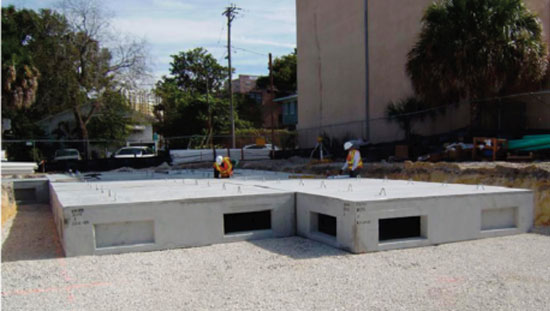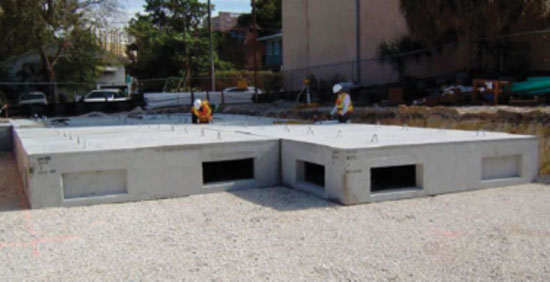Green Building: Essential Design Strategies for a Sustainable Future
Case Studies
| Horizon Bay Congregate Living Facility Uses Green StormWater Detention Infrastructure | ||
A unique precast concrete subsurface stormwater detention infrastructure was specifically engineered and designed to accommodate both the stormwater storage capacity demands and the load-bearing needs of the land use above them, at the new Horizon Bay Congregate Living Facility located in Tampa, Fla. The Horizon Bay project needed to be able to capture stormwater and pipe it to 6,572 CF of stormwater detention under the parking area to absorb and detain the stormwater and allow water to slowly infiltrate into the ground, assisting in recharging the groundwater. Limited available site space necessitated the use of an underground stormwater detention structure beneath the facility parking lot. Underground detention was the only practical choice according to design engineer Fuxan Engineering of Odessa, Fla. An overflow pipe led to storm sewers, but the majority of the stormwater would be infiltrated back into the ground; a common low-impact development (LID) practice in Florida that serves to help recharge the aquifer. The “green” precast concrete module detention system provided a much better value proposition to the owner and engineer in place of the plastic underground storage chambers originally proposed for the site. The module system is ideally suited for this type of underground detention application due to its stand-alone, traffic-bearing design which does not rely on final paving and associated stone underlayment for structural capacity. The precast modules are constructed of high-strength structural concrete. Their ability to support traffic on the parking lot allowed for a 50% reduction in thickness of base rock required between the pavement and modules, as well as a 20% reduction under the modules, as compared to the originally planned plastic chambers. The completed system design for Horizon Bay included 37 modules. Each module is constructed of precast reinforced concrete with interior dimensions of 6 ft x 12 ft x 2.5 ft tall, with open bottom for infiltration. Four of the modules incorporated standard inlet grates to allow stormwater direct entry from the parking lot into the system. This eliminated the need for the four separate inlet structures originally designed into the project. A precast splash pad was installed below each inlet grate to prevent scour of the bedding material. In addition, the inlet grates are used for direct access to the modules for inspection and cleaning as needed. Each module has large conveyance windows into adjacent modules to allow flow equalization, as well as access for maintenance. This was the first project where Ripa Construction used this precast stormwater detention module system. Ripa Construction’s project managers stated that the modules were a key component to providing access for a very limited site and did not require ongoing maintenance or cleanout during construction. The initial savings experienced from the reduction of aggregates in the foundation, backfill and under the pavement are hard, tangible costs. Ripa believes that coupling those savings with the experience they gained in the ease and speed of installation and lack of construction maintenance will make this system very useful in future projects. |
| New Modular Stormwater Management System | ||
A new underground structural precast concrete system for stormwater management consisting of an array of modules can be used for infiltration, detention, or retention and reuse, as well as for treatment-train systems. This modular stormwater system features a stand-alone, traffic-bearing design which does not rely on final paving and associated stone underlayment, or on specific stone backfill for structural capacity and storage. Precast modules are constructed of high-strength concrete and are installed on a simple setting bed of stone that is up to 20% less than other systems. Their ability to support traffic allows for minimal cover with pavement options of asphalt, concrete or concrete pavers. Standard inlet grates allow stormwater direct entry from a roadway surface into the system, eliminating the need for separate inlet structures. The system incorporates direct access for inspection and cleaning through grates, manholes or removable slabs, as well as a maintenance module for sustainability. Overall, precast modules have a smaller footprint with more storage capacity, and allow for rapid installation due to no select backfill requirements. The system can be installed early in the development process without fear of damage during construction. |











